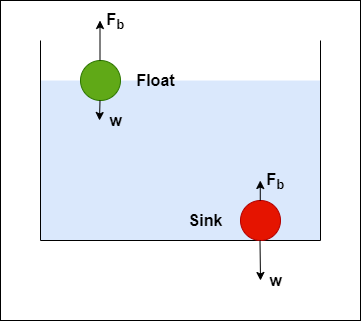Physics - Classical Mechanics - Archimedes' Principle and Buoyancy

[Image1]
Introduction
Hey it's a me again @drifter1!
Today we continue with Physics, and more specifically the branch of "Classical Mechanics", in order to talk about Archimedes' Principle and Buoyancy.
So, without further ado, let's get straight into it!
Buoyant Force
When an object is submerged into a fluid, the fluid exerts an upward force to it. This force is known as buoyant force. Buoyancy (also called upthrust) is the exact reason why some objects float and others do not. So, the buoyant force is an upward force that's exerted on any object in any fluid.

Buoyancy is related to the increase in pressure with depth in a fluid. There is always a difference in pressure between the bottom and the top of a submerged object. The pressure from the top is of course less than the pressure exerted upward from the bottom.
If the force exerted through this pressure is greater than the object's weight the object will rise to the surface of the fluid and float. If it's less the object will start sinking, until it eventually reaches the bottom. So, the buoyant force is always present whether the object floats, sinks or stays suspended at the same depth (the force equals its weight).
Archimedes' Principle
Up to this point we only covered the basic concept of buoyancy. Let's now get into how we determine the exact value of the buoyant force.
The answer is given by Archimedes' principle, which states that the buoyant force on an submerged object is equal to the weight of the fluid it displaces:

Let's try to understand this equation better, by proving it!
Proof
The buoyant force is the net force acting upon the object. The pressure from the sides is cancelled out. And so, the only important forces are a force Fdown from the top that pushes the object down, and a force Fup from the bottom which pushes the object up. So, the buoyant force thus equals:

Relating these forces to pressure, yields:

Of course, in this calculations we are again talking about a cylinder. So, the final term can be replaced by the volume V of the cylinder. This volume also equals the volume of the displaced fluid. So, putting this instead yields:

And with that we've proven the principle!
Common Mistakes
There are some common mistakes that are made when applying the principle that need to be mentioned. The term ρ refers to the density of the fluid and not of the submerged object. The volume V refers to the volume of the displaced fluid, which doesn't necessarily have to be equal to the entire volume of the submerged object. Lastly, a common misconception is that the buoyant force changes with depth, which is not true as it's the same at any depth.
Relation with Density
The density of an object also determines whether it floats. If it's less than the surrounding fluid it will float. That's because the fluid with higher density contains more mass and thus more weight in the same volume. The buoyant force will therefore be greater than the weight of the submerged object.
The ratio of the submerged volume to the total volume of the object is defined as the fraction submerged:

Obtaining a relationship between the densities is now a simple substitution:

When floating the masses are equal and can be cancelled out, which yields:

So, if the density of the object is less than that of the fluid, some "part" of it will float. Otherwise, the complete object will be submerged, which basically means that the object will sink.
RESOURCES:
References
- https://courses.lumenlearning.com/suny-osuniversityphysics/chapter/14-4-archimedes-principle-and-buoyancy/
- https://www.khanacademy.org/science/physics/fluids/buoyant-force-and-archimedes-principle/a/buoyant-force-and-archimedes-principle-article#:~:text=buoyant%20force%20is%20the%20upward,weight%20of%20the%20displaced%20fluid.
Images
Mathematical equations used in this article, where made using quicklatex.
Visualizations were made using draw.io.
Previous articles of the series
Rectlinear motion
- Velocity and acceleration in a rectlinear motion -> velocity, acceleration and averages of those
- Rectlinear motion with constant acceleration and free falling -> const acceleration motion and free fall
- Rectlinear motion with variable acceleration and velocity relativity -> integrations to calculate pos and velocity, relative velocity
- Rectlinear motion exercises -> examples and tasks in rectlinear motion
Plane motion
- Position, velocity and acceleration vectors in a plane motion -> position, velocity and acceleration in plane motion
- Projectile motion as a plane motion -> missile/bullet motion as a plane motion
- Smooth Circular motion -> smooth circular motion theory
- Plane motion exercises -> examples and tasks in plane motions
Newton's laws and Applications
- Force and Newton's first law -> force, 1st law
- Mass and Newton's second law -> mass, 2nd law
- Newton's 3rd law and mass vs weight -> mass vs weight, 3rd law, friction
- Applying Newton's Laws -> free-body diagram, point equilibrium and 2nd law applications
- Contact forces and friction -> contact force, friction
- Dynamics of Circular motion -> circular motion dynamics, applications
- Object equilibrium and 2nd law application examples -> examples of object equilibrium and 2nd law applications
- Contact force and friction examples -> exercises in force and friction
- Circular dynamic and vertical circle motion examples -> exercises in circular dynamics
- Advanced Newton law examples -> advanced (more difficult) exercises
Work and Energy
- Work and Kinetic Energy -> Definition of Work, Work by a constant and variable Force, Work and Kinetic Energy, Power, Exercises
- Conservative and Non-Conservative Forces -> Conservation of Energy, Conservative and Non-Conservative Forces and Fields, Calculations and Exercises
- Potential and Mechanical Energy -> Gravitational and Elastic Potential Energy, Conservation of Mechanical Energy, Problem Solving Strategy & Tips
- Force and Potential Energy -> Force as Energy Derivative (1-dim) and Gradient (3-dim)
- Potential Energy Diagrams -> Energy Diagram Interpretation, Steps and Example
- Internal Energy and Work -> Internal Energy, Internal Work
Momentum and Impulse
- Conservation of Momentum -> Momentum, Conservation of Momentum
- Elastic and Inelastic Collisions -> Collision, Elastic Collision, Inelastic Collision
- Collision Examples -> Various Elastic and Inelastic Collision Examples
- Impulse -> Impulse with Example
- Motion of the Center of Mass -> Center of Mass, Motion analysis with examples
- Explaining the Physics behind Rocket Propulsion -> Required Background, Rocket Propulsion Analysis
Angular Motion
- Angular motion basics -> Angular position, velocity and acceleration
- Rotation with constant angular acceleration -> Constant angular acceleration, Example
- Rotational Kinetic Energy & Moment of Inertia -> Rotational kinetic energy, Moment of Inertia
- Parallel Axis Theorem -> Parallel axis theorem with example
- Torque and Angular Acceleration -> Torque, Relation to Angular Acceleration, Example
- Rotation about a moving axis (Rolling motion) -> Fixed and moving axis rotation
- Work and Power in Angular Motion -> Work, Work-Energy Theorem, Power
- Angular Momentum -> Angular Momentum and its conservation
- Explaining the Physics behind Mechanical Gyroscopes -> What they are, History, How they work (Precession, Mathematical Analysis) Difference to Accelerometers
- Exercises around Angular motion -> Angular motion examples
Equilibrium and Elasticity
- Rigid Body Equilibrium -> Equilibrium Conditions of Rigid Bodies, Center of Gravity, Solving Equilibrium Problems
- Force Couple System -> Force Couple System, Example
- Tensile Stress and Strain -> Tensile Stress, Tensile Strain, Young's Modulus, Poisson's Ratio
- Volumetric Stress and Strain -> Volumetric Stress, Volumetric Strain, Bulk's Modulus of Elasticity, Compressibility
- Cross-Sectional Stress and Strain -> Shear Stress, Shear Strain, Shear Modulus
- Elasticity and Plasticity of Common Materials -> Elasticity, Plasticity, Stress-Strain Diagram, Fracture, Common Materials
- Rigid Body Equilibrium Exercises -> Center of Gravity Calculation, Equilibrium Problems
- Exercises on Elasticity and Plasticity -> Young Modulus, Bulk Modulus and Shear Modulus Examples
Gravity
- Newton's Law of Gravitation -> Newton's Law of Gravity, Gravitational Constant G
- Weight: The Force of Gravity -> Weight, Gravitational Acceleration, Gravity on Earth and Planets of the Solar System
- Gravitational Fields -> Gravitational Field Mathematics and Visualization
- Gravitational Potential Energy -> Gravitational Potential Energy, Potential and Escape Velocity
- Exercises around Newtonian Gravity (part 1) -> Examples on the Universal Law of Gravitation
- Exercises around Newtonian Gravity (part2) -> Examples on Gravitational Fields and Potential Energy
- Explaining the Physics behind Satellite Motion -> The Circular Motion of Satellites
- Kepler's Laws of Planetary Motion -> Kepler's Story, Elliptical Orbits, Kepler's Laws
- Spherical Mass Distributions -> Spherical Mass Distribution, Gravity Outside and Within a Spherical Shell, Simple Examples
- Earth's Rotation and its Effect on Gravity -> Gravity on Earth, Apparent Weight
- Black Holes and Schwarzschild Radius -> Black Holes (Creation, Types, How To "See" Them), Schwarzschild Radius
Periodic Motion
- Periodic Motion Fundamentals -> Fundamentals (Period, Frequency, Angular Frequency, Return Force, Acceleration, Velocity, Amplitude), Simple Harmonic Motion, Example
- Energy in Simple Harmonic Motion -> Forms of Energy in SHM (Potential, Kinetic, Total and Maximum Energy, Maximum Velocity), Simple Example
- Simple Harmonic Motion Equations -> SHM Equations (Displacement, Velocity, Acceleration, Phase Angle, Amplitude)
- Simple Harmonic Motion and Reference Circle -> SHM and Smooth Circular Motion, Reference Circle
- Simple Harmonic Motion Exercises -> 2 Complete Examples on Simple Harmonic Motion
- Simple Pendulum -> Simple Pendulum (Return Force, Small Angle Approximations, More Accurate Period, Gravity Approximation)
- Physical Pendulum -> Physical Pendulum (Return Torque, Small Angle Approximations, Estimating Moment of Inertia)
- Exercises around Pendulums -> Complete Examples on the 2 types of Pendulums (Simple, Physical)
- Damped Oscillation -> Damping Force, Total Force and Differential Equation, Motion Equations, Special Cases
- Forced Oscillation and Resonance -> Forced Oscillation (Differential Equation, Amplitude, Resonance)
- Exercises around Damped and Forced Oscillation -> Complete Examples on Damped Oscillation and Forced Oscillation
- Chaos and Chaotic Oscillation -> Chaos, Unpredictability and Randomness, Chaotic Oscillation
Fluid Mechanics
- Density and Pressure -> Fluids and Fluid Mechanics, Density, Specific Gravity, Pressure
- Measuring Pressure in Fluids -> Pressure in Fluids (Variation with Depth), Absolute and Gauge Pressure, Measuring Pressure
- Pascal's Principle and Hydraulics -> Static Equilibrium, Pascal's Principle, Hydraulic Systems
Final words | Next up
And this is actually it for today's post!
Next time we will get into Surface Tension...
See ya!

Keep on drifting!
Posted with STEMGeeks
Thanks for your contribution to the STEMsocial community. Feel free to join us on discord to get to know the rest of us!
Please consider delegating to the @stemsocial account (85% of the curation rewards are returned).
You may also include @stemsocial as a beneficiary of the rewards of this post to get a stronger support.